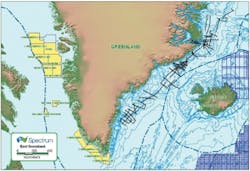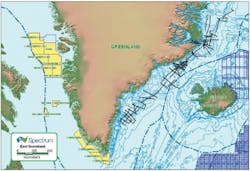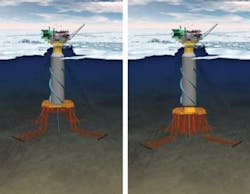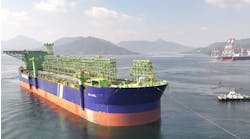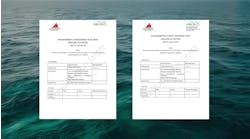Data visualization, real-time monitoring improve drilling efficiency
Cary Purdy
Landmark/Halliburton
Exploration and development drilling operations are all too frequently impaired by formation fluid influx (kicks), drilling fluid losses (hydraulic fractures), and wellbore instability due to shear failure. In a 2004 industry study published in Offshore, it was revealed that these events cost the industry almost $8 billion every year. Even with advances in pre-drill modeling, this number has not decreased significantly since the study was conducted. Indeed, a recent internal study by a major oil company cited that 44% of their non-productive time (NPT) was associated with improper management of annular pressures which resulted in geopressure and wellbore instability related problems during well drilling operations.
Examples of recently drilled wells using a software package in which geopressure, earth stress and wellbore stability analyses are fully integrated with modern visualization technology, and the ability to update analyses (actual versus planned) in real time demonstrate that operators can eliminate or mitigate a significant portion of the geopressure and wellbore instability problems and reduce NPT.
Reducing NPT
While the E&P industry has successfully leveraged new technology to lower finding and lifting costs, there is still substantial room for improvement through the expanded and innovative use of new technologies such as data visualization and real time monitoring. Non-productive time during drilling operations is one area of inefficiency that is always under scrutiny. Non-productive time caused by mechanical failures, weather, and logistical problems can add substantial overhead to operations. Other non-productive time induced by kicks, losses, and wellbore instability issues can account for as much as 40% of the total non-productive time. Indeed, published reports estimate that geopressure-related non-productive drilling time costs the industry over $8 billion per year. While non-productive time cannot be completely eliminated, reductions can result in lower drilling costs and improved health, safety, and environmental performance.
To attack non-productive time related to drilling operations, three areas must be addressed:
- Planning – using data available to schedule activities and build contingencies based on known risks and uncertainty
- Real time surveillance – using data and communications technologies to monitor activities and make corrections that optimize performance
- Knowledge management – capturing the information from planning and operations, securing the appropriate software products, and sharing them throughout the organization.
With so many technology-related advances, why do costs related to non-productive time remain so high? At least part of the reason can be attributed to a lack of real-time monitoring and updating, as well as a general inability to visualize updates in 3D against the drilling plan and the prospect's geology and geophysical projection. Knowledge, information, and data must be captured, secured, and shared in systems which are intuitive and easy to use by a wide range of professionals. The right information needs to get to the right person, at the right time and in the right format. Case studies have demonstrated that a reduction in non-productive drilling time by 20% is achievable through the use of real-time monitoring and updates. If non-productive time costs the industry $8 billion per year, a 20% savings amounts to $1.6 billion. That's a significant amount of money that could be used to fund additional drilling, directed toward research and development projects, or distributed as stakeholder profits.
Visualization
With performance and economic advances in computer hardware and embedded visualization applications, advanced visualization in the desktop environment is now enabling geoscientists and engineers to generate a more comprehensive "picture story" from field data to geologic model to drilling and well completion.
A Gulf of Mexico well drilled using the mud program from a previous well without doing pore pressure prediction calculations or doing real time monitoring and analysis to update the program during drilling.
Hardware and software advances have come together to support visualizations that incorporate scales from basin-wide seismic to reservoir scales while also supporting static and dynamic models. These capabilities offer the ability to provide data transformations with interpretation for improved rock and fluid property interpretation. This means geoscientists and engineers can now take advantage of continuous visualization through real-time updating for faster and improved decision making. Visualization of real-time data combined with existing model data tends to enhance and enrich connections between geophysics, petrophysics, interpretation, and drilling engineering groups. This leads to near real-time solutions rather than a decoupled post-visualization solution.
Planning and monitoring
First, let us examine a case which could have benefited from a real time analysis of the safe operating envelope. Operations with construction budgets of less than $7 million typically do not consider the cost-benefit relationship suitable for comprehensive NPT reduction strategies; however, as this case will show, that is a costly assumption. The following is a Gulf of Mexico well. The well program was a simple slant well with a 10,000 ft kick-off point and 2,500 ft in which to build to 50 degrees of inclination. The target was at ~15,000 ft measured depth. The pre-drill pore pressure prognosis was based solely upon offset mud weights; basically, it was a "cut and paste" from the original well's mud program. (It should be noted that the original well was a vertical well.) No pre-drill wellbore stability analysis was performed by the operator. Maximum required mud weight was expected to be less than 10.9 ppg. Drilling proceeded for ~5,000 ft to 10,000 ft, measured depth, at which time inclination was built per the drilling program. Almost immediately following the kick-off, tight hole and hole fill were reported. The problems persisted and increased in frequency and magnitude through the build section. Stuck pipe was encountered and freed; however, drilling conditions were difficult. Hole conditions finally deteriorated to the point where a mud weight increase was ordered. The mud weight was increased by 0.6 ppg to achieve 11.5 ppg at 13,820 ft measured depth. Yet, the problems persisted and so did drilling. The mud weight was again raised at 14,130 ft measured depth, with similar poor results. Finally, at ~14,250 ft measured depth, a well flow was observed and the entire open hole was lost during the kill operations. This cost the operator almost $5 million and several weeks of time.
Results from the second Gulf of Mexico example well. With wellbore planning that includes pore pressure and wellbore stability calculations along with real time updates of planned versus actual calculations this well experienced no problems or NPT attributed to wellbore problems associated with pressure or wellbore instability.
While the mud weights selected during the pre-drill were adequate to prevent fluid influx to 13,750 ft measured depth, they were insufficient to prevent wellbore collapse. The collapse pressures exceeding the pore pressures resulted from the wellbore geometry. As inclination was built, stress anisotropy increased around the wellbore as the difference between the horizontal and vertical stress components mounted.
In the Gulf of Mexico, the horizontal stresses are frequently very similar in magnitude, and shear failure in vertical and near vertical wells is generally not problematic. Unfortunately, as inclination is built, the differences in the vertical and horizontal components do create shear stresses and these must be managed with additional annular fluid pressure (mud weight).
The wellbore instability was certainly problematic, but not dire. The defining moment in this operation occurred in the form of formation fluid influx (kick). The kick was not detectable using gas or drilling indicators; however, a simple resistivity analysis performed by a competent analyst with state of the art technology accurately predicted the location and magnitude of the event with little difficulty. While this was done in hindsight, there is no reason to believe that a similar analysis could not have been done in real time, with the identical information.
What can be learned from this example? All operations must properly consider the implications of improperly managing the safe operating envelope during well construction. The proper management of this envelope begins with the pre-drill quantification of pore pressures, fracture pressures and shear failure pressures.
This pre-drill analysis must be updated in real time as new information becomes available at the wellsite. In this particular case, the survey information coupled with LWD resistivity and gamma ray was sufficient to predict the events that eventually caused the loss of the wellbore. As previously mentioned, the key is getting the right information to the right person, at the right time, in the right format so that it may be included in the decision making process during drilling operations.
Demonstrating the benefits
In a second Gulf of Mexico example, the operator recognized the potential for wellbore collapse based solely on the proposed wellbore geometry, which included inclinations of almost 80 degrees at total depth.
Petrophysical analysis of measured while drilling data was used to estimate shale pore pressures behind the bit while drilling, using the same techniques utilized in the pre-drill analysis. These results were compared to the pre-drill model prediction. In this case, the formations used in the pre-drill compaction model came in at depths other than expected, and the shale pressure deviated sufficiently from the pre-drill prediction, requiring that the model be updated and a new pressure prediction produced.
This updated model matched the estimated pressure in the drilled section and predicted the shale pressures ahead of the bit for the rest of the well, improving the predictability ahead of the bit as the well progressed. As drilling continued the revised model was updated as needed. A key feature for accurately updating the predictive pore pressure model for the well was the ability to visualize the model with seismic data attribute volumes and structural and stratigraphic frameworks. Through integrated data visualization, the predictive model is improved significantly over alternative methods that do not incorporate visualization of ancillary data.
This well had a far superior result to the well in the previous example. In this case, the operator conducted a comprehensive internal analysis prior to spud, and then contracted a vendor to mitigate the remaining uncertainty in real time.
In spite of the pre-drill and real-time prognoses diverging very soon after well construction began, real-time updates monitored by the right people with the appropriate software were able to adjust the mud program while drilling. This resulted in correct management of the safe operating envelope, and hence no problems with wellbore instability, pore pressure or fracture pressure.
Offshore Articles Archives
View Oil and Gas Articles on PennEnergy.com
